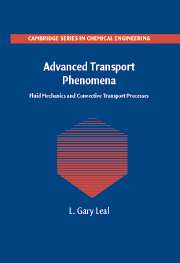Book contents
- Frontmatter
- Contents
- Preface
- Acknowledgments
- 1 A Preview
- 2 Basic Principles
- 3 Unidirectional and One-Dimensional Flow and Heat Transfer Problems
- 4 An Introduction to Asymptotic Approximations
- 5 The Thin-Gap Approximation – Lubrication Problems
- 6 The Thin-Gap Approximation – Films with a Free Surface
- 7 Creeping Flow – Two-Dimensional and Axisymmetric Problems
- 8 Creeping Flow – Three-Dimensional Problems
- 9 Convection Effects in Low-Reynolds-Number Flows
- 10 Laminar Boundary-Layer Theory
- 11 Heat and Mass Transfer at Large Reynolds Number
- 12 Hydrodynamic Stability
- Appendix A Governing Equations and Vector Operations in Cartesian, Cylindrical, and Spherical Coordinate Systems
- Appendix B Cartesian Component Notation
- Index
5 - The Thin-Gap Approximation – Lubrication Problems
Published online by Cambridge University Press: 05 June 2012
- Frontmatter
- Contents
- Preface
- Acknowledgments
- 1 A Preview
- 2 Basic Principles
- 3 Unidirectional and One-Dimensional Flow and Heat Transfer Problems
- 4 An Introduction to Asymptotic Approximations
- 5 The Thin-Gap Approximation – Lubrication Problems
- 6 The Thin-Gap Approximation – Films with a Free Surface
- 7 Creeping Flow – Two-Dimensional and Axisymmetric Problems
- 8 Creeping Flow – Three-Dimensional Problems
- 9 Convection Effects in Low-Reynolds-Number Flows
- 10 Laminar Boundary-Layer Theory
- 11 Heat and Mass Transfer at Large Reynolds Number
- 12 Hydrodynamic Stability
- Appendix A Governing Equations and Vector Operations in Cartesian, Cylindrical, and Spherical Coordinate Systems
- Appendix B Cartesian Component Notation
- Index
Summary
In Chap. 4 we explored the consequences of a weak departure from strict adherence to the conditions for unidirectional flow; namely, the effect of slight curvature in flow through a circular tube. For that case, the centripetal acceleration associated with the curved path of the primary flow was shown to produce a weak secondary motion in the plane orthogonal to the tube axis. In this chapter we consider another class of deviations from unidirectional flow that occur when the boundaries are slightly nonparallel.
If the boundaries of the flow domain are not parallel, the magnitude of the primary velocity component must vary as a function of distance in the flow direction. This not only introduces a number of new physical phenomena, as we shall see, but it also means that the Navier–Stokes equations cannot be simplified following the unidirectional flow assumptions of Chap. 3, and exact analytical solutions are no longer possible. In this chapter, we thus consider only a special limiting case, known as the “thin-gap” limit, in which the distance between the boundaries is small compared with the lateral gap width. In this case, we shall see that we can obtain approximate analytical solutions by using the asymptotic and scaling techniques that were introduced in the preceding chapter.
The resulting theory, at the leading order of approximation, is applicable to a number of important phenomena. There are two generic classes of problems.
Information
- Type
- Chapter
- Information
- Advanced Transport PhenomenaFluid Mechanics and Convective Transport Processes, pp. 294 - 354Publisher: Cambridge University PressPrint publication year: 2007
